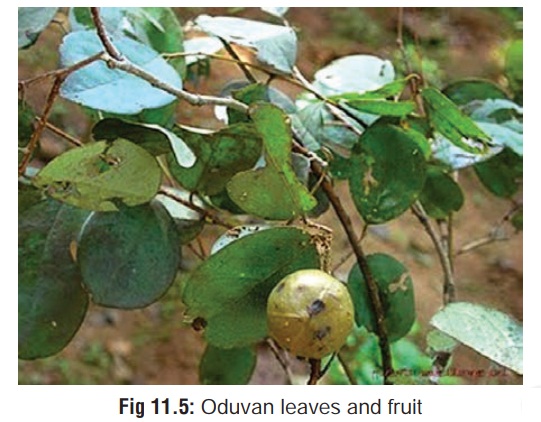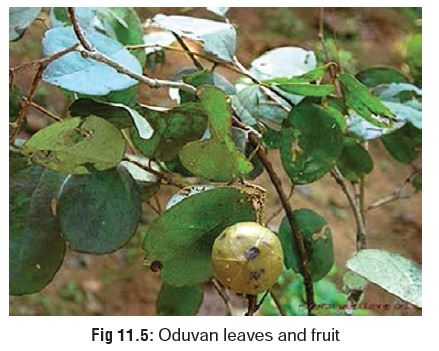Chapter: Modern Medical Toxicology: Organic Poisons (Toxins): Plants of Special Importance
Oduvan - Organic Poisons (Toxins)

Oduvan
Other Common Names
·
Oduvanthalai/Nillipalai (Tamilnadu and Pondicherry); Kadishe (Andhra Pradesh ); Karlajuri (West Bengal); Garari (Hindispeaking States of India).
Botanical Name
·
Cleistanthus
collinus.
Physical Appearance
· Cleistanthus collinusbelongs to family Phyllanthaceae (some-times placed in Euphorbiaceae), and grows wild in dry hills of various parts of India from Himachal Pradesh to Bihar, and
·
It is a small, deciduous tree with
spreading, smooth branches. Leaves are orbicular, broadly ovate or elliptical,
with rounded tips (Fig 11.5).
·
Flowers are borne in small axillary
clusters.
·
The fruit capsule is large, somewhat
trigonous, woody, dark- brown, and appears shining and wrinkled when dry. Seeds
are globose and chestnut-brown in colour.


Toxic Part and Principles
·
All parts of the plant are
poisonous.
·
Extract of the various plant parts
yield a multitude of compounds of which the glycosides, arylnaphthalene lignin
lactones are toxic. These lignan lactones include cleistanthin A and B,
collinusin and diphyllin, which in the past were known collectively as
“oduvin”.
Clinical Features
·
In one Indian case series, clinical
features in those who died included vomiting, epigastric pain, breathlessness,
visual disturbances (clouding/blurring/coloured vision), giddiness, drowsiness,
fever, tachycardia, hypotension and/or respira-tory arrest. Survivors were
asymptomatic, or transiently symptomatic with abdominal pain, visual symptoms
and giddiness.
·
A recent case report highlighted
ARDS, distal renal tubular acidosis, and distributive shock secondary to
inappropriate vasodilatation.
·
Neuromuscular weakness at
presentation has been docu-mented.
Diagnosis
·
ECG changes may include QTc
prolongation and non-specific ST-T changes.
·
Blood biochemistry may reveal
hypokalaemia, increased AST/LDH/CPK/CPK-MB levels, hyponatraemia,
hyper-bilirubinaemia and elevated urea levels.
· ABG may show evidence of metabolic
acidosis, hypoxia, and a widened alveolar- arterial O2
gradient/difference (A-aDO2 gap), especially in those with
respiratory failure.
Treatment
· Correction of metabolic acidosis
with sodium bicarbonate.
· Correction of hypokalaemia with IV
potassium chloride.
·
N-acetylcysteine 150 mg/kg over 1
hour, followed by 50 mg/kg over 4 hours, and 100mg/kg over the next 16 hours,
has been suggested as beneficial.
Forensic Issues
Cases
of suicide accomplished with parts of the Oduvan plant have been on the increase
in recent times, in several parts of India, especially Tamil Nadu and Andhra
Pradesh. Accidental poisoning has also been reported.
Related Topics